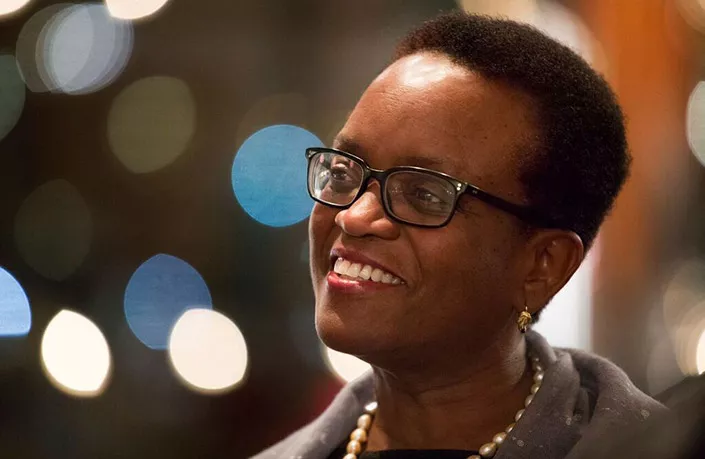President Smith Shares Vision for the Future of Swarthmore College

At Friday’s plenary session of the Board of Managers, Swarthmore College President Valerie Smith shared her vision for the future of the College, including a list of priorities for her presidency.
Smith concentrated her priorities on three key areas: access and inclusion, academics, and education for the common good.
Regarding access and inclusion, Smith aims to build a more welcoming and inclusive community. While noting that the College will continue to recruit, admit, and support a diverse student body—ensuring that no qualified students will be denied access to a Swarthmore education because of their financial circumstances—Smith plans to raise and invest funds for financial aid, student support services, and the “hidden costs” of education, such as helping disadvantaged students pay for course materials and health care. She also called for renovating and constructing new spaces that will allow for informal, serendipitous interactions between and among students, staff, and faculty.
“These types of initiatives will help us create an environment that is inclusive and welcoming to students, faculty, and staff whatever their backgrounds, country of origin, sexual orientation, and or cultural, political, and religious affiliations,” she says.
On academics, Smith will invest in the College’s academic core mission in ways that respect tradition while responding to contemporary challenges.
This includes increasing faculty diversity; supporting faculty development; responding to changing staffing needs both in traditional departments and interdisciplinary programs; investing in beyond-the-classroom learning experiences, such as summer research opportunities, internships, and off-campus trips that are embedded in courses; and continuing to invest in academic spaces to support pedagogical innovation.
“Swarthmore’s reputation for academic excellence depends upon its ability to recruit and retain outstanding and dedicated scholar/teachers; to offer a curriculum that is both innovative and yet grounded in the traditional disciplines; that integrates civic and social engagement; and that supports student independent research,” she says.
Smith also called for the College to commit explicitly to the value of educating the whole person by investing in athletics; health and wellness; and spiritual and religious life; among other programs and activities that contribute to the well-being and social and cultural development of students.
“We acknowledge the mutually dependent relationship between students’ academic and extracurricular lives and achievements. These initiatives certainly benefit students, but they benefit the entire community as well,” she says.
Finally, Smith pledged to expand and continue the College’s tradition of serving the common good by creating opportunities for faculty, staff, and students to address some of the most pressing and urgent issues that confront humanity.
Her plan includes working in collaboration with institutions of all kinds in Delaware County and the greater Philadelphia region; creating a comprehensive strategy for creating international partnerships for research, teaching, and service; and addressing climate change and the issue of sustainability in effective ways that encompass teaching, research, and operations.
Along with meeting with the Board of Managers, President Smith delivered her priorities to multiple audiences throughout the spring semester, including faculty, staff, and students.
Smith established her priorities for the College during a lengthy listening tour that kicked off her presidency, where she met with staff, faculty, students, neighbors in the surrounding communities, and alumni around the country.
The ambitious agenda will require some creative, collaborative thinking and planning, according to Smith, but she is confident the Swarthmore community is up to the task.
“I truly believe that we are creating a community in which everyone—staff, faculty, students, alumni, and friends—has the potential to be a lifelong learner, and that we have much we can learn from each other,” she says. “My highest hope is that our community will embrace our common humanity as well as our dazzling array of differences. As we become an increasingly diverse community, we will cultivate curiosity about ideas and experiences and beliefs that challenge us, about people who are different from us, and experiences that are unfamiliar.”



